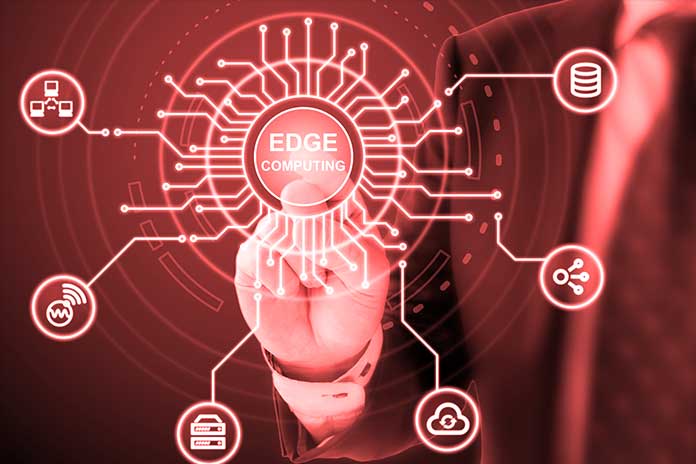Edge computing technologies are becoming more attractive for many industries with the growing popularity of AI and IoT. Fast processors and flexibly usable edge modules favor the increasing variety of application scenarios.
Companies turned over around 7.6 billion euros in 2018 with world market innovations based on artificial intelligence (AI) – this is the result of a study by ZEW Mannheim on behalf of the Federal Ministry for Economic Affairs and Energy (BMWi). Accordingly, the use of AI has a noticeable effect on the return on sales and enables significantly higher profit margins. The study illustrates what has been in the offing for several years: artificial intelligence is increasingly turning from a pure concept into a real business case.
The basis for the economical use of technology remains demanding. IT planners have to develop realistic application scenarios and calculate with ever more significant amounts of data: They need a constant and well-coordinated data flow to build robust and reliable AI models.
Since the framework conditions are anything but ideal in practice, this becomes the crux of the matter in many scenarios. Specialists who, for example, want to have the maintenance intervals of machine parts determined based on sensor data need not only a well-trained AI model but also short paths for the data. If these first have to be in the cloud for the analysis, the decisive information comes too late in case of doubt to react adequately to irregularities.
In recent years, edge servers have solved such problems by processing the data at the edge of the network – i.e., on-site, without going through a remote cloud data center. The built-in processors are developing rapidly and are now opening up more and more possibilities for the technology.
Constant Learning Process Across All Edge Devices
Solutions such as the Atlas 500 AI Edge Station from Huawei can also be used for more demanding scenarios due to their compact and robust design. For example, the modules can process data from complex, intelligent city concepts, such as real-time analysis of pedestrian and vehicle movements to improve traffic flow.
In such a scenario, the technology has to function under adverse conditions such as very high or low temperatures and process large amounts of camera data. If these were first sent to the cloud for analysis, the timing required for a traffic light switch could no longer be guaranteed – the latency in communication with the distant servers in the data center is too pronounced.
However, powerful AI processors process the information directly on site in the Edge Server and feed it back to the traffic light system with the appropriate conclusions, which now reacts promptly to the current traffic situation. MEANWHILE, the AI model used is constantly trained and further developed through updates from the cloud and thus achieves better and better results over time. Uniform devise management then distributes the updated algorithms to all edge devices in the network. There is a constant learning process across the individual modules, and necessary firmware upgrades are installed promptly and seamlessly.
The principle of edge computing can be transferred to many other use cases. For example, a corresponding solution can also ensure quality management in production processes: sensor or camera data record any production errors detected by the AI in the edge device. The responsible employee receives a warning and can react accordingly. By repeating this process, error detection will improve over time. Logistics processes also benefit from the technology, for example, when specialists connect automated storage and picking systems via edge devices and can thus react much more quickly to irregularities in the process.
Increased Transparency Through Open-Source Frameworks
Edge technologies must have protection mechanisms to ensure security in industrial scenarios. Ideally, these are already created in the development environment and regularly check the AI model for any weaknesses that could lead to distortions or misinterpretations. At the same time, it is essential that third parties cannot draw any conclusions about sensitive information when processing personal data. The trained model and all traffic between cloud and edge are therefore encrypted.
Meanwhile, open-source frameworks such as MindSpore, TensorFlow, or PyTorch increase transparency in data processing since the source code is publicly accessible and developers can clearly understand the algorithms. The choice of development environment plays an important role when building an intelligent edge solution: it requires uniform APIs and robust functions for the development, execution, and deployment of AI models. High resource efficiency and accessibility for developers bring clear benefits.
The Edge Infrastructure Market Is Growing
In the ideal interaction, edge solutions with strong AI processors can enable imaginative city concepts or intelligent production systems and support the implementation of automated robotic solutions or autonomous transport systems. Due to the rapidly growing performance of the technology, the variety of conceivable application scenarios is increasing. Therefore, the great interest in edge computing is anything but a fleeting trend.
” The edge will eat the cloud,” Gartner analyst Thomas Bittman wrote back in 2017, warning that, given the vast potential, it will soon be necessary to have an edge strategy. Current forecasts show he wasn’t wrong: according to IDC, the market for IoT edge infrastructure is expected to grow to $16 billion by 2023.
Also Read: The Impact Of Edge Computing In The Automotive Sector

